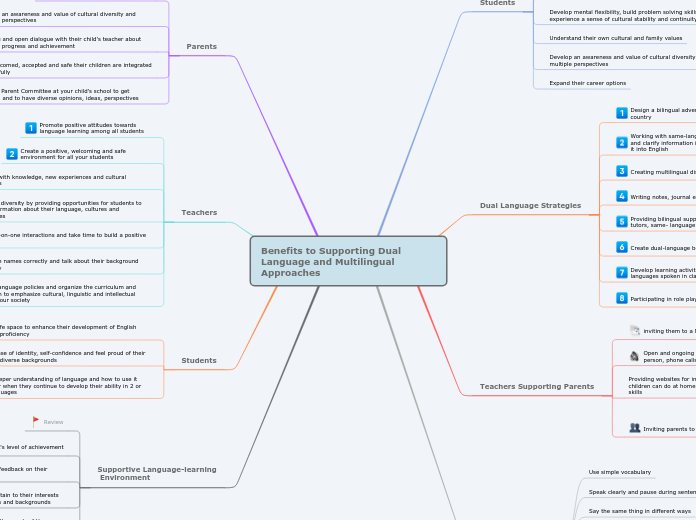Benefits to Supporting Dual Language and Multilingual Approaches
Students
Known experiences provides reassurance, in which students are more accessible to acquire new skills and concepts
Develop proficiency in their first language while learning English helps them academically and socially because knowledge about concepts and language skills are transferrable
They can preserve family ties, cultural backgrounds and sense of their identity
Develop mental flexibility, build problem solving skills, experience a sense of cultural stability and continuity
Understand their own cultural and family values
Develop an awareness and value of cultural diversity and multiple perspectives
Expand their career options
Dual Language Strategies
Design a bilingual advertisement to attract visitors to a country
Working with same-language partners who discuss a problem and clarify information in the first language before translating it into English
Creating multilingual displays or signs
Writing notes, journal entries in your dominant language
Providing bilingual support: Room partners, cross-grade tutors, same- language partners for think, pair, share activities
Create dual-language books, display/read dual language books
Develop learning activities that take advantage of the first languages spoken in class (compare letters, numbers, objects)
Participating in role plays, puppet shows, movies (visual)
Teachers Supporting Parents
inviting them to a Meet and Greet
Open and ongoing dialogue about students progress (in person, phone calls, emails, communication book)
Providing websites for information and suggesting activities children can do at home to continue to practice their English skills
Inviting parents to the classroom and engaging in activities
Watching role plays, puppet shows, presentations
Guest speaker to read a dual language book, share about their culture, traditions, child-parent activities
Effective Practices
Use simple vocabulary
Speak clearly and pause during sentences
Say the same thing in different ways
Use visuals (images, objects), gestures and body language to display information
Check in with students on their level of understanding and progress
Modify tasks
Give students more time to process questions and responses
Parents
Preserve family ties, cultural background
Develop an awareness and value of cultural diversity and multiple perspectives
Ongoing and open dialogue with their child's teacher about learning progress and achievement
Feel welcomed, accepted and safe their children are integrated successfully
Join the Parent Committee at your child's school to get involved and to have diverse opinions, ideas, perspectives
Teachers
Promote positive attitudes towards language learning among all students
Create a positive, welcoming and safe environment for all your students
Enriched with knowledge, new experiences and cultural awareness
Celebrate diversity by providing opportunities for students to share information about their language, cultures and experiences
Have one-on-one interactions and take time to build a positive rapport
Pronounce names correctly and talk about their background and family
Develop language policies and organize the curriculum and instruction to emphasize cultural, linguistic and intellectual capital of our society
Students
Have a safe space to enhance their development of English language proficiency
Builds sense of identity, self-confidence and feel proud of their culturally diverse backgrounds
Gain a deeper understanding of language and how to use it effectively when they continue to develop their ability in 2 or more languages
Supportive Language-learning
Environment
Review
Tasks are appropriate to the student's level of achievement
Give English language learners positive feedback on their efforts
Engage all students in activities that pertain to their interests and build on their prior knowledge, skills and backgrounds
Space is flexible and adaptable to meet the needs of the students
